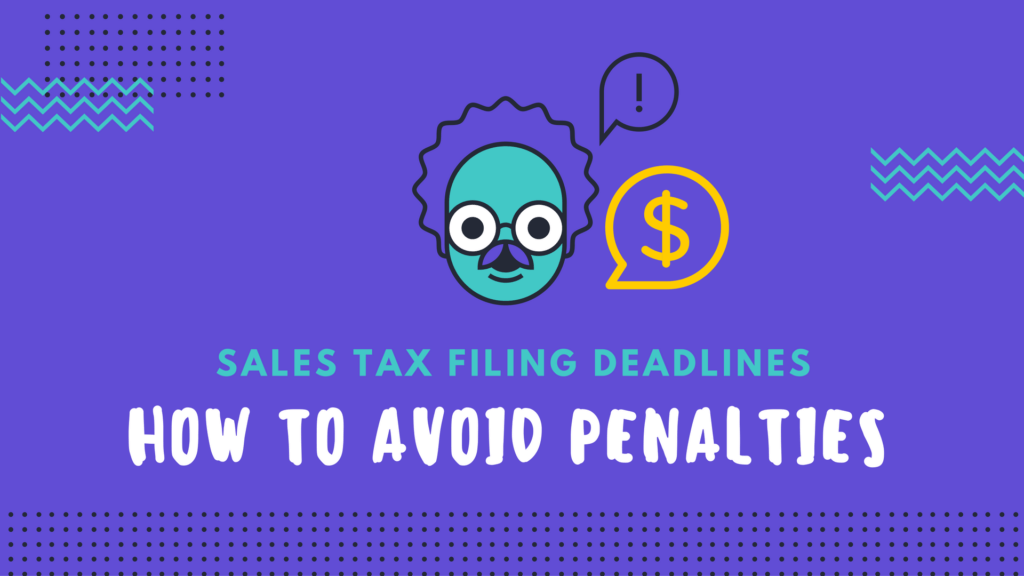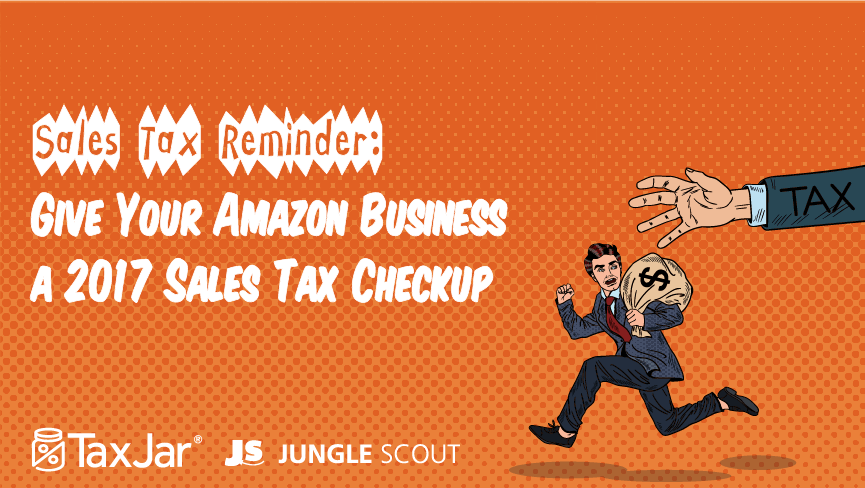With the new year arriving, us Amazon sellers are going to be thinking about a big topic. Sales Tax. I know it’s not the most exciting thing to talk about, but it’s a necessary task and when it’s done right, you can save yourself some money along the way.
I’ve been catching up with the team at TaxJar, and CEO Mark Faggiano has a few tips for your 2017 sales tax checkup if you’re an Amazon.com FBA seller. Check it out!
_______
The beginning of a new year is a fantastic time to evaluate what went right (and wrong) in the previous year, and make big plans to kick butt in the year to come. As a business owner, it’s worth it to take this time to assess your current business processes and decide if there’s anyway you can “work smarter, not harder.”
One business process that tends to bog ecommerce sellers down is sales tax.
Sales tax is an ubiquitous administrative hassle. Most everyone has to deal with it, but since states don’t provide great guidance on exactly how to collect and file, many online sellers can’t feel confident they’re doing sales tax “correctly.”
That’s where giving your sales tax processes a good once-over comes in. Read on to find out how to evaluate your sales tax activities now so you can get on with a happy and prosperous 2017!
Why should you give yourself a sales tax checkup?
Forty-five U.S. state and Washington D.C. all have a sales tax. Any retailer, including online sellers, is required to collect sales tax from buyers in states where they have nexus (more on that below). Retailers collect a percentage of sales tax on each taxable sale and then remit those funds to the state.
States and local areas (such as cities, counties and other special taxing districts) use the money collected by retailers to pay for budget items like schools, transportation and public safety. Many U.S. states and localities make the majority of their revenue from sales tax, so they are very interested in making sure that retailers collect, file and remit sales tax!
That said, you should never have to pay sales tax out of pocket! Sales tax is a “pass through tax,” meaning that you collect it from your customer and pass it on to the state. You should never spend your own profits to comply with state sales tax laws.
Ready for your checkup? Let’s dig in.
Take Stock
Ask yourself how much time you spent on sales tax last year? If you spent more than a few minutes per filing, you’re probably spending too much time on an administrative activity that doesn’t make your business a profit.
Also, what nags at or concerns you every time you file a sales tax return? Are you afraid you aren’t filling out all of the cities, counties and districts correctly? Or afraid you aren’t collecting the right amount of sales tax from your customers in the first place? Maybe you sell on multiple channels and aren’t sure you’re collecting the right amount of sales tax on each.
Before you can fix the problem, first know what it is!
Determine Where You Have Sales Tax Nexus
As a retailer, you are only required to collect sales tax from customers in states where you have sales tax nexus. Sales tax nexus is just a legalese way of saying “a significant connection” to a state. Though every state’s nexus laws are slightly different, nexus is generally created in the following ways:
- A location – an office, warehouse, store, or other physical place of business
- Personnel – an employee, contractor, salesperson, installer or other person doing work for your business
- Inventory – Most states consider storing inventory in the state to cause nexus even if you have no other place of business or personnel
- Affiliates – Someone who advertises your products in exchange for a cut of the profits creates nexus in many states
- A drop shipping relationship – If you have a 3rd party ship to your buyers, you may create nexus
- Selling products temporarily at a tradeshow or other event – Some states consider you to have nexus even if you only sell there temporarily
You can see what creates sales tax nexus in each state here.
The first of the year is a good time to double check if your recent business activities may have caused you to have sales tax nexus in a new state.
If you do find that you have sales tax nexus in a new state, you should register for a sales tax permit in that state and begin collecting sales tax. Don’t skip this step! Collecting sales tax without a permit is illegal. (States think you’re keeping their money for yourself!)
Not sure your business activities are lucrative enough to collect sales tax? Check out the “When Should You Register for a Sales Tax Permit” post from some guidance
On the other hand, you may have stopped doing certain business activities that gave you sales tax nexus. If you find that you no longer have nexus in a state, you can cancel your sales tax permit in that state. When you do, just double check with the state to make sure they don’t have any “trailing nexus” provision that require you to collect sales tax for a few months to year after your nexus in the state has been abolished.
Also, once you’ve cancelled your sales tax permit in a state, be sure you are no longer collecting sales tax from buyers in that state on any of the online shopping carts and marketplaces on which you sell. One of the biggest mistakes we see at TaxJar is online sellers forgetting to collect (or stop collecting) sales tax on one of their carts or marketplaces.
Know Your Sales Tax Filing Frequency
You’re not the only person who will be completing a sales tax checkup at the beginning of the year. Many states do, too! And this may mean that they change your sales tax filing frequency.
You were assigned a filing frequency when you first signed up for your sales tax permit. At that time, your state assigned you to pay sales tax either monthly, quarterly or annually.
States generally assign you to file and pay sales tax more often if you are a high-volume seller. Around this time of year, some states will evaluate the amount of sales tax you are collecting and remitting over a period of time. Then they will change your filing frequency to either more or less often. Be on the lookout for a letter or other communication from your state’s department of revenue in case they change your filing frequency!
Know Your Sales Tax Filing Due Dates
Once you are sure of your sales tax filing frequency, you should the note your sales tax filing due dates.

In the majority of states, sales tax is due on the 20th of the month after the filing period. For example, if you are a quarterly sales tax filer in the state of Georgia, your Q1 sales tax return would be on April 20th – the 20th day of the month after Q1 is over.
Other states want to hear from you on different days. California’s sales tax filing due date isn’t until the last day of the month after the filing period. Florida’s sales tax filing is technically due on the first day of the month after the filing period ends. But you have until the 20th of the month before the filing is considered late.
It’s important that you pay on time, because every state assesses penalties and interest for late filings. Plus, about half the states with a sales tax offer sales tax discounts (generally, a very small percentage of the amount of sales tax you collected) to businesses that file on time!
Your Sales Tax Processes as an Amazon Seller
There are a few reasons why you may be spending too much time on your sales tax returns. You may sell on multiple channels and have a hard time reconciling all of your sales. Or you may find yourself spending hours filling out your sales tax amounts collected within in each state, county, city and special taxing district.
If this is too time consuming, you can use a sales tax automation solution to make your sales tax life simple. You can connect each of the online shopping carts and marketplaces you sell on. From there, you’ll receive a return-ready sales tax report with your sales broken down just the way your state wants to see them. You can even AutoFile your sales tax in most states, meaning you never need to look at your sales tax filings ever again.
Sales tax is a necessary part of your business, but it doesn’t make you any money. If you’re spending too much time on sales tax, try automating it so you can get back to doing what you do best – running your business.
Want to know more about sales tax? Check out our Sales Tax Guide for Amazon FBA Sellers.
About The Author

Mark Faggiano is the Founder and CEO of TaxJar, a service that makes sales tax reporting and filing simple for more than 5,000 online sellers. Try a 30-day-free trial of TaxJar today and eliminate sales tax compliance headaches from your life!

 2 Comments
2 Comments
2 comments on “Amazon Business Sales Tax: An Introduction”